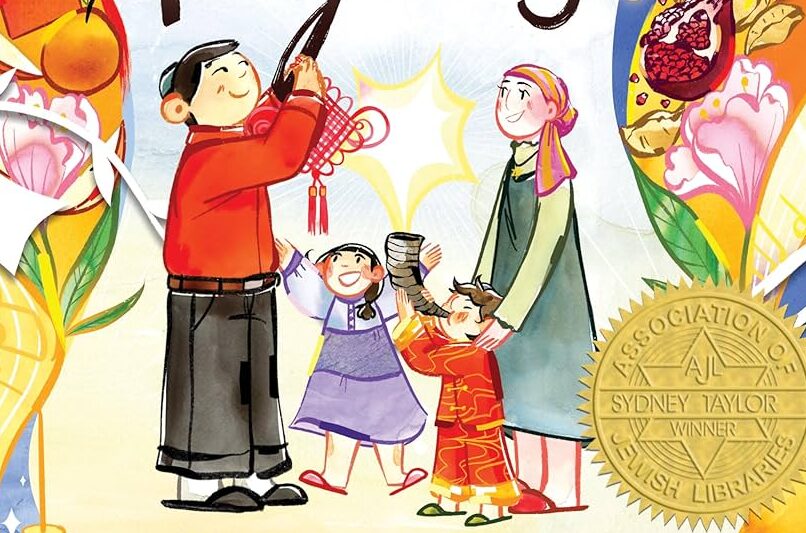Two New Years: A Children’s Book
Celebrating Jewish American Heritage Month and Asian American and Pacific Islander Heritage Month through Richard Ho’s award-winning picture book.
Published May 24, 2024

Cover of "Two New Years," illustrated by Lynn Scurfield
Jewish American Heritage Month and Asian American and Pacific Islander Heritage Month are both celebrated in May in the United States, and what a gorgeous blend these two traditions can make! Each of these cultures is sufficiently rich and beautiful in its own right, but just like we learn so much from visiting a friend from a different background, or maybe trying a new food or reading a new book, there’s a special satisfaction in finding a place where these two celebrations intersect. And it’s especially satisfying when that place is a picture book you can hold in your hands and enjoy with children for years and new years to come.
Richard Ho, a Jewish and Chinese-American author, wrote Two New Years, illustrated by Lynn Scurfield, about the blending of differences and similarities that come with celebrating both Rosh Hashanah and the Lunar New Year as a family. The book is simple in text and conception, but rich in atmosphere and sensory experience. No wonder it won both the Sydney Taylor Book Award for picture books and the Children’s Picture Book Tracy and Larry Brown Family Award in the National Jewish Book Awards! It’s a lovely thing to see these awards go to a book exemplifying joy and togetherness and an unequivocal pride in one’s heritage and identity.
“My family celebrates two New Years,” the book opens. And the pictures accompanying that first page of text show an Orthodox Jewish family: on one side of the spread you see them dipping apple slices in honey while a shofar is on the table, and on the other side they’re dressed in red and sharing treats and lucky red envelopes for Lunar New Year.
As the book moves along, the flow is gentle: Richard Ho speaks as himself, unpretentiously, sharing where the holidays come from and what he loves in each. The text describes sweeping old troubles out the door and casting mistakes into a stream as we say goodbye to the past year, and moves on to gathering with family to celebrate the new. It talks about symbolic foods, lanterns and songs, and ultimately brings all the traditions together in the concluding line: “A shared year of double blessings.”
Though normally I’m not a fan of backmatter, Richard Ho’s author’s note is essential here, sharing his story in greater depth, and describing how “the Chinese and Jewish aspects of my life turned out to be more aligned than I ever would have hoped.”
The celebration of this alignment of different aspects comes through perfectly in a spread showing the father and mother holding hands and smiling into each other’s eyes: the mother in her headscarf and star of David necklace and the father in his kippah are each framed in a papercut, hers in blue and white tones representing Jewish symbols and his in red and gold with Chinese symbols. The image is a lovely nod to how each culture has papercuts in its artistic roots, but have developed the method in different ways.
As a reader, the first thing I noticed, before even registering that the dad in the family was Chinese, was that the mother in the picture was wearing a headscarf and long skirt, and I felt my heart swell and got choked up. But the blending with the Chinese tradition gave me a new source of joy. Too often, Jewish picture books are solely Ashkenazi and show the Eastern European background exclusively. This is not representative of our Jewish world. I loved seeing my Ashkenazi self represented on the page, but I also love to see a new angle—and one that I know will thrill not only my children, but many others.
Because we, too, have recently started, in a mild way, celebrating Lunar New Year in my family. My daughter, a voracious reader, is a passionate fan of author-illustrator Grace Lin. We’ve read about the Lunar New Year and the Mid-Autumn Moon Festival. We’ve made jiaozi and debated how feasible it is to make mooncakes at home. (We did not succeed in that endeavour.)
To see the traditions she’s read of as another’s culture on the page with what she knows to be our own culture is to build a new bridge, and, this joint JAHM and AAPIHM, what’s better than a bridge?
Deborah Furchtgott is a children's book reviewer at The Children's Bookroom.
Reflections
-
1.
What is your favorite time to come together as a group, whether with family or friends?
-
2.
Is there a time you’ve joined someone else’s gathering? What did that feel like?
-
3.
What about the other way—have you invited someone new to a traditional gathering? What did they bring to the table?
-
4.
Is there a Jewish holiday you always spend with others? Which is it, and what does it mean to you to have a group for it?
-
5.
Is your Jewish identity singular (Ashkenazi or Sephardic, perhaps) or is it mixed with other cultural elements?
Want more?
Get curated JewishArts.org content in your inbox


